2.10: Negative Statements
- Page ID
- 2143
\( \newcommand{\vecs}[1]{\overset { \scriptstyle \rightharpoonup} {\mathbf{#1}} } \)
\( \newcommand{\vecd}[1]{\overset{-\!-\!\rightharpoonup}{\vphantom{a}\smash {#1}}} \)
\( \newcommand{\dsum}{\displaystyle\sum\limits} \)
\( \newcommand{\dint}{\displaystyle\int\limits} \)
\( \newcommand{\dlim}{\displaystyle\lim\limits} \)
\( \newcommand{\id}{\mathrm{id}}\) \( \newcommand{\Span}{\mathrm{span}}\)
( \newcommand{\kernel}{\mathrm{null}\,}\) \( \newcommand{\range}{\mathrm{range}\,}\)
\( \newcommand{\RealPart}{\mathrm{Re}}\) \( \newcommand{\ImaginaryPart}{\mathrm{Im}}\)
\( \newcommand{\Argument}{\mathrm{Arg}}\) \( \newcommand{\norm}[1]{\| #1 \|}\)
\( \newcommand{\inner}[2]{\langle #1, #2 \rangle}\)
\( \newcommand{\Span}{\mathrm{span}}\)
\( \newcommand{\id}{\mathrm{id}}\)
\( \newcommand{\Span}{\mathrm{span}}\)
\( \newcommand{\kernel}{\mathrm{null}\,}\)
\( \newcommand{\range}{\mathrm{range}\,}\)
\( \newcommand{\RealPart}{\mathrm{Re}}\)
\( \newcommand{\ImaginaryPart}{\mathrm{Im}}\)
\( \newcommand{\Argument}{\mathrm{Arg}}\)
\( \newcommand{\norm}[1]{\| #1 \|}\)
\( \newcommand{\inner}[2]{\langle #1, #2 \rangle}\)
\( \newcommand{\Span}{\mathrm{span}}\) \( \newcommand{\AA}{\unicode[.8,0]{x212B}}\)
\( \newcommand{\vectorA}[1]{\vec{#1}} % arrow\)
\( \newcommand{\vectorAt}[1]{\vec{\text{#1}}} % arrow\)
\( \newcommand{\vectorB}[1]{\overset { \scriptstyle \rightharpoonup} {\mathbf{#1}} } \)
\( \newcommand{\vectorC}[1]{\textbf{#1}} \)
\( \newcommand{\vectorD}[1]{\overrightarrow{#1}} \)
\( \newcommand{\vectorDt}[1]{\overrightarrow{\text{#1}}} \)
\( \newcommand{\vectE}[1]{\overset{-\!-\!\rightharpoonup}{\vphantom{a}\smash{\mathbf {#1}}}} \)
\( \newcommand{\vecs}[1]{\overset { \scriptstyle \rightharpoonup} {\mathbf{#1}} } \)
\( \newcommand{\vecd}[1]{\overset{-\!-\!\rightharpoonup}{\vphantom{a}\smash {#1}}} \)
\(\newcommand{\avec}{\mathbf a}\) \(\newcommand{\bvec}{\mathbf b}\) \(\newcommand{\cvec}{\mathbf c}\) \(\newcommand{\dvec}{\mathbf d}\) \(\newcommand{\dtil}{\widetilde{\mathbf d}}\) \(\newcommand{\evec}{\mathbf e}\) \(\newcommand{\fvec}{\mathbf f}\) \(\newcommand{\nvec}{\mathbf n}\) \(\newcommand{\pvec}{\mathbf p}\) \(\newcommand{\qvec}{\mathbf q}\) \(\newcommand{\svec}{\mathbf s}\) \(\newcommand{\tvec}{\mathbf t}\) \(\newcommand{\uvec}{\mathbf u}\) \(\newcommand{\vvec}{\mathbf v}\) \(\newcommand{\wvec}{\mathbf w}\) \(\newcommand{\xvec}{\mathbf x}\) \(\newcommand{\yvec}{\mathbf y}\) \(\newcommand{\zvec}{\mathbf z}\) \(\newcommand{\rvec}{\mathbf r}\) \(\newcommand{\mvec}{\mathbf m}\) \(\newcommand{\zerovec}{\mathbf 0}\) \(\newcommand{\onevec}{\mathbf 1}\) \(\newcommand{\real}{\mathbb R}\) \(\newcommand{\twovec}[2]{\left[\begin{array}{r}#1 \\ #2 \end{array}\right]}\) \(\newcommand{\ctwovec}[2]{\left[\begin{array}{c}#1 \\ #2 \end{array}\right]}\) \(\newcommand{\threevec}[3]{\left[\begin{array}{r}#1 \\ #2 \\ #3 \end{array}\right]}\) \(\newcommand{\cthreevec}[3]{\left[\begin{array}{c}#1 \\ #2 \\ #3 \end{array}\right]}\) \(\newcommand{\fourvec}[4]{\left[\begin{array}{r}#1 \\ #2 \\ #3 \\ #4 \end{array}\right]}\) \(\newcommand{\cfourvec}[4]{\left[\begin{array}{c}#1 \\ #2 \\ #3 \\ #4 \end{array}\right]}\) \(\newcommand{\fivevec}[5]{\left[\begin{array}{r}#1 \\ #2 \\ #3 \\ #4 \\ #5 \\ \end{array}\right]}\) \(\newcommand{\cfivevec}[5]{\left[\begin{array}{c}#1 \\ #2 \\ #3 \\ #4 \\ #5 \\ \end{array}\right]}\) \(\newcommand{\mattwo}[4]{\left[\begin{array}{rr}#1 \amp #2 \\ #3 \amp #4 \\ \end{array}\right]}\) \(\newcommand{\laspan}[1]{\text{Span}\{#1\}}\) \(\newcommand{\bcal}{\cal B}\) \(\newcommand{\ccal}{\cal C}\) \(\newcommand{\scal}{\cal S}\) \(\newcommand{\wcal}{\cal W}\) \(\newcommand{\ecal}{\cal E}\) \(\newcommand{\coords}[2]{\left\{#1\right\}_{#2}}\) \(\newcommand{\gray}[1]{\color{gray}{#1}}\) \(\newcommand{\lgray}[1]{\color{lightgray}{#1}}\) \(\newcommand{\rank}{\operatorname{rank}}\) \(\newcommand{\row}{\text{Row}}\) \(\newcommand{\col}{\text{Col}}\) \(\renewcommand{\row}{\text{Row}}\) \(\newcommand{\nul}{\text{Nul}}\) \(\newcommand{\var}{\text{Var}}\) \(\newcommand{\corr}{\text{corr}}\) \(\newcommand{\len}[1]{\left|#1\right|}\) \(\newcommand{\bbar}{\overline{\bvec}}\) \(\newcommand{\bhat}{\widehat{\bvec}}\) \(\newcommand{\bperp}{\bvec^\perp}\) \(\newcommand{\xhat}{\widehat{\xvec}}\) \(\newcommand{\vhat}{\widehat{\vvec}}\) \(\newcommand{\uhat}{\widehat{\uvec}}\) \(\newcommand{\what}{\widehat{\wvec}}\) \(\newcommand{\Sighat}{\widehat{\Sigma}}\) \(\newcommand{\lt}{<}\) \(\newcommand{\gt}{>}\) \(\newcommand{\amp}{&}\) \(\definecolor{fillinmathshade}{gray}{0.9}\)Truth values for negation of conditional statements, conjunctions, and disjunctions.
In everyday speech, negative statements are often ambiguous or unclear. Mathematically, you need a precise way to negate statements so that you can accurately determine whether statements are true or false. When is the negation of the following sentence true?
If I am not cold then it is not snowing.
Negations
While in everyday language the opposite of “dog” might be “cat”, in mathematics the opposite of “dog” is “not a dog”. Using the word “not” is the basic way to negate an atomic sentence. An atomic sentence is a logical statement without logical connectives that has a truth value.
- Original sentence \((D)\): That thing is a dog.
- Negation of sentence \((\sim D)\): That thing is not a dog.
The box below represents the universe of all things. This universe can be separated into things that are dogs and things that are not dogs.
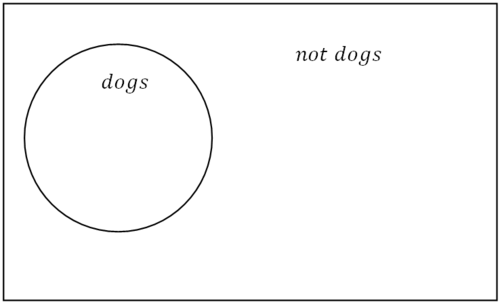 Figure \(\PageIndex{1}\)
Figure \(\PageIndex{1}\)To negate complex statements that involve logical connectives like or, and, or if-then, you should start by constructing a truth table and noting that negation completely switches the truth value.
The negation of a conditional statement is only true when the original if-then statement is false.
| \(P\) | \(Q\) | \(P \rightarrow Q\) | \(\sim (P \rightarrow Q)\) |
| T | T | T | F |
| T | F | F | T |
| F | T | T | F |
| F | F | T | F |
The negation of a conjunction is only false when the original two statements are both true. A conjunction is two statements that are joined by an "and".
| \(P\) | \(Q\) | \(P \wedge Q\) | \(\sim (P \wedge Q)\) |
| T | T | T | F |
| T | F | F | T |
| F | T | F | T |
| F | F | F | T |
The negation of a disjunction is only true when both of the original statements are false. A disjunction is two statements that are joined by an "or".
| \(P\) | \(Q\) | \(P \lor Q\) | \(\sim (P \lor Q)\) |
| T | T | T | F |
| T | F | T | F |
| F | T | T | F |
| F | F | F | T |
Set theory circles can also be used to interpret the negation of a disjunction or a conjunction.
The shaded portion in the box represents the area that is within \(P\) or within \(Q\). Recall that in mathematical logic, this is written as \(P \lor Q\). In set theory this area is represented similarly as \(P \cup Q\) where the symbol \(\cup\) stands for union. While the notation is slightly different, the reasoning about the relationships and implications is identical.
 Figure \(\PageIndex{2}\)
Figure \(\PageIndex{2}\)When you negate the statement, you completely switch what is shaded.
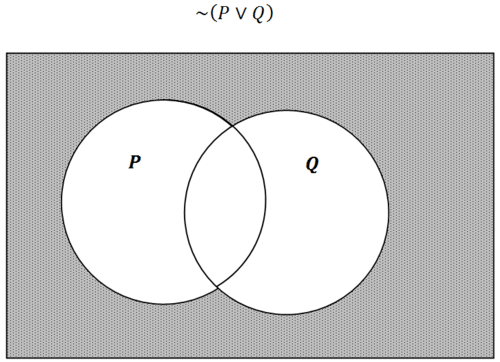 Figure \(\PageIndex{3}\)
Figure \(\PageIndex{3}\)A different way to think about this shaded region is that it is the region that is not in P and also not in Q. This means that \(\sim (P \lor Q)\) is equivalent to \(\sim P \wedge \sim Q\).
\(\sim (P \lor Q)\Leftrightarrow \sim P \wedge \sim Q\)
The symbol “\(\Leftrightarrow\)” works in mathematical logic and set theory the same way “\(=\)” works in arithmetic and algebra. In this case, the negative appears to distribute throughout the or statement by negating each statement individually and changes the or statement to an and statement. This is called De Morgan’s Law.
Negating a conjunction gives a similar result.
The shaded portion in the box represents the area that is within P and within \(Q\). In mathematical logic this is written as \(P \wedge Q\). In set theory this area is represented similarly as \(P \cap Q\) where the symbol \(\cap\) stands for intersection. As before, the notation between mathematical logic and set theory is slightly different. However, the reasoning about the relationships and the logical implications are identical.
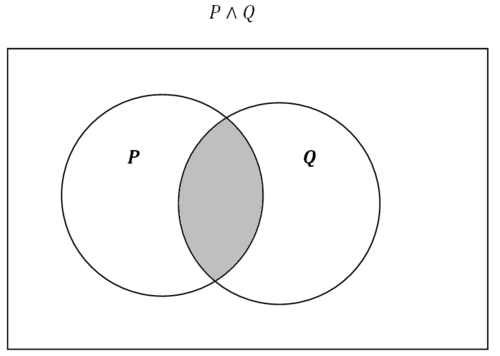 Figure \(\PageIndex{4}\)
Figure \(\PageIndex{4}\)When you negate the statement, you completely switch what is shaded.
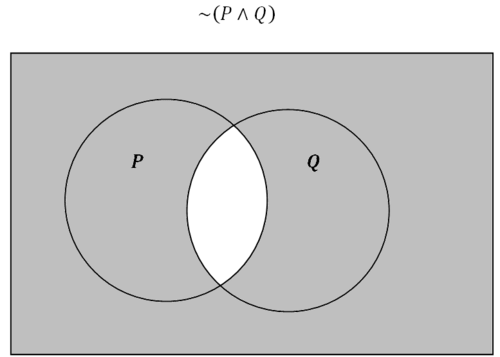 Figure \(\PageIndex{5}\)
Figure \(\PageIndex{5}\)A different way to think about this shaded region is to consider that it represents everything that isn’t in \(P\) or isn’t in \(Q\).
\(\sim (P \wedge Q) \Leftrightarrow \sim P \lor \sim Q\)
This is a second representation of De Morgan’s Law.
As mathematical sentences become more complex with additional connectives, truth tables and set theory circles are good ways to interpret when the statements are true and when the statements are false.
Example \(\PageIndex{1}\)
Earlier, you were asked when the negation of the following statement is true.
If I am not cold, then it is not snowing.
The statement already has several negative parts, so it is incorrect to simply switch one or both of the negations.
- \(P=I\: am\: cold.\)
- \(Q=It\: is\: snowing.\)
Solution
| \(P\) | \(Q\) | \(\sim P\) | \(\sim Q\) | \(\sim P \rightarrow \sim Q\) | \(\sim ( \sim P \rightarrow \sim Q)\) |
| T | T | F | F | T | F |
| T | F | F | T | T | F |
| F | T | T | F | F | T |
| F | F | T | T | T | F |
Start by building up to the original statement. Then, add a column that completely negates the original statement. Notice that there is only one row where the final negated statement is true. That is when \(P\) is false and \(Q\) is true. Therefore, the negation of the original sentence is true when “I am not cold” and “it is snowing”.
Example \(\PageIndex{2}\)
Use set theory circles to interpret the negation of a conditional statement and explain how the negation of a conditional can be written in a different way.
Solution
The shaded portion in the box represents the area that makes the following statement true.
 Figure \(\PageIndex{6}\)
Figure \(\PageIndex{6}\)Notice that there are four different regions in the Venn Diagram which correspond to the four different rows of the conditional truth table. The only space that does not make the statement true is when \(P\) is true (inside circle \(P\)) and \(Q\) is false (outside circle \(Q\)).
| \(P\) | \(Q\) | \(P \rightarrow Q\) |
| T | T | T |
| T | F | F |
| F | T | T |
| F | F | T |
To negate this statement, you switch the values in the truth table and switch the shaded region in the Venn Diagram.
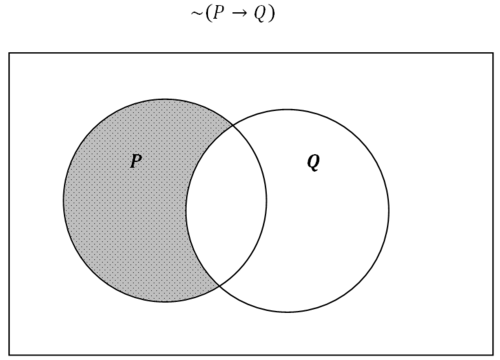 Figure \(\PageIndex{7}\)
Figure \(\PageIndex{7}\)A different way to think about this shaded region is to see it as the space that is in \(P\) but not in \(Q\).
\(\sim (P \rightarrow Q) \Leftrightarrow P \wedge \sim Q\)
Example \(\PageIndex{3}\)
Show that the following statements are equivalent in a truth table. The symbol \(\equiv\) means equivalent. To be equivalent in this case means to be true at the same time and false at the same time.
\(P \wedge Q \equiv \sim ( \sim P \lor \sim Q)\)
Solution
While a truth table is not a proof, it can help you recognize when two statements have the same truth values.
| \(P\) | \(Q\) | \(\sim P\) | \(\sim Q\) | \(\sim P \lor \sim Q\) | \(\sim ( \sim P \lor \sim Q)\) | \(P \wedge Q\) |
| T | T | F | F | F | T | T |
| T | F | F | T | T | F | F |
| F | T | T | F | T | F | F |
| F | F | T | T | T | F | F |
Notice that the final two columns are identical.
Example \(\PageIndex{4}\)
Write a sentence in two different ways illustrating the mathematical statement in Example 3
Solution
\(P \wedge Q\): I like movies and I like TV. \(\sim ( \sim P \lor \sim Q)\): It is not the case that either I don’t like movies or I don’t like TV.
Example \(\PageIndex{5}\)
A tautology is a logical statement that is always true. Demonstrate the following tautology in a truth table.
\(B \rightarrow (A \lor \sim A)\)
Solution
| \(A\) | \(\sim A\) | \(B\) | \(A \lor \sim A\) | \(B \rightarrow (A \lor \sim A)\) |
| T | F | F | T | T |
| T | F | T | T | T |
| F | T | T | T | T |
| F | T | F | T | T |
Notice that the last column is all T's. This means that this statement is always true and therefore is a tautology.
Review
I’m either going to go skiing or snowboarding next weekend.
1. Identify the atomic statements in the above sentence and use logical connectives to rewrite the sentence with symbols.
2. Write the negation of the sentence with symbols and write the negation of the sentence in words in a natural way.
Mike and John both ate lunch with me.
3. Identify the atomic statements in the above sentence and use logical connectives to rewrite the sentence with symbols.
4. Write the negation of the sentence with symbols and write the negation of the sentence in words in a natural way.
Neither my brother nor my sister wants to play with me.
5. Identify the atomic statements in the above sentence and use logical connectives to rewrite the sentence with symbols.
6. Write the negation of the sentence with symbols and write the negation of the sentence in words in a natural way.
Write negations for the following statements.
7. All dogs go to heaven.
8. My teacher is seldom wrong.
9. Everyone likes pizza.
Make truth tables for each of the following.
10. \((P \wedge Q) \lor \sim Q\)
11. \(P \wedge (Q \lor \sim Q)\)
12. \((P \lor Q) \lor \sim R\)
13. \(( \sim P \wedge \sim Q) \lor \sim R\)
14. What is the simplest statement that is equivalent to #11: \(P \wedge (Q \lor \sim Q)\)?
15. Use De Morgan’s Law to find a statement equivalent to the following statement: \(\sim (Q \lor \sim Q)\)
16. Use De Morgan’s Law to find a statement equivalent to the following statement: \(\sim (P \lor Q) \lor \sim R\)
Vocabulary
| Term | Definition |
|---|---|
| atomic statement | An atomic statement is a declarative statement without logical connectives that has a truth value. |
| conjunction | A conjunction is an "and" statement, which is a statement that combines two logical statements and is only true when both statements are true. The symbol for “and” is “ \(\wedge\) ”. |
| De Morgan's law | De Morgan’s law transforms a conjunction into a disjunction using negation. |
| disjunction | A disjunction is an "or" statement that combines two logical statements, and is only false when both statements are false. The symbol for “or” is “ \(\lor\)”. |
| negation | The negation of a statement is the opposite of the statement. If the original statement is \(D\), then the negation of the statement is represented by \(\sim D\). A statement and its negation will always have opposite truth values. |
| tautology | A tautology is a logical statement that is always true. A tautology is a type of basic theorem. |
Additional Resource
Practice: Negative Statements

